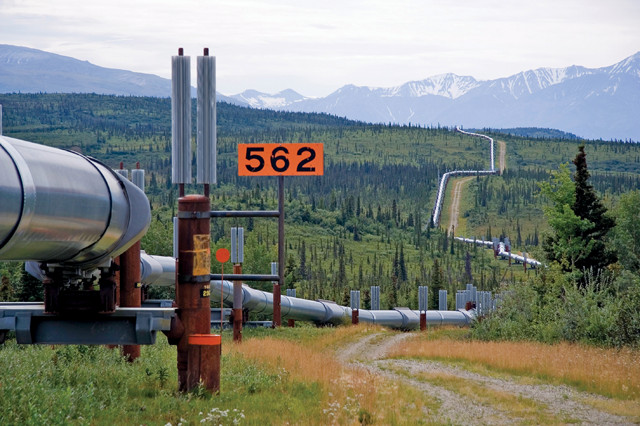
by Mary Caperton Morton Friday, August 11, 2017

Clogs caused by the formation of gas hydrates are a major concern for oil and gas pipeline operators. Water-repellent films coating the inside of pipes could prevent hydrate formation. Credit: Luca Galuzzi, CC BY-SA 2.5.
When ice forms in household water pipes, blockages and expansion can cause the pipes to burst. Similar problems can arise in the transportation of oil and gas when ice-like substances called gas hydrates build up inside pipelines — an issue traditionally mitigated by insulating pipes or by using antifreeze additives. But in a new study published in the journal ACS Applied Materials and Interfaces, researchers report an alternative solution: specialized coatings for the inside of oil and gas pipes that prevent hydrate buildups and clogs. The coatings could prove more reliable than the usual approaches, but whether the method can be applied cost-effectively on a large scale is uncertain.
Gas hydrates, or clathrates, consist of frozen water molecules entrapping gases like methane inside a crystalline solid. Once thought only to occur in the frigid cold of space, gas hydrates have been found in abundance on seafloors around the world, from high latitudes to the tropics, and in permafrost soils in the Arctic. They can also precipitate out from water-rich petroleum or drilling fluids at low temperatures and/or high pressures.
Hydrates are “a major problem for the [oil and gas] industry, for both safety and reliability” reasons, said Kripa Varanasi, a mechanical engineer at MIT and a co-author of the new study, in a statement. When the material clumps together on pipe walls, it can form blockages that cause leaks or even catastrophic pipeline failures.
Insulating the outside of pipes and adding glycol- or alcohol-based chemicals to the mixtures running through the pipes prevents hydrate formation. But insulating many kilometers of large-diameter pipe is expensive, and the chemical additives are often environmentally unfriendly and sometimes ineffective.
The new method developed by Varanasi and his colleagues instead uses a textured coating applied to pipe walls to promote the formation of a water-repellent film by attracting liquid hydrocarbons already present in petroleum, which then prevent gas hydrates from sticking. In laboratory tests, the team found that when a film of cyclopentane — used as a chemical proxy for methane because methane hydrates only form under high-pressure conditions that are difficult to reproduce in the lab — was induced to form inside a container, no cyclopentane hydrates adhered to the container walls.
“This study demonstrates the potential of coatings for preventing hydrate buildup” in pipes, but the method may prove to be cost-prohibitive to use at scale, says Amadeu Sum, a chemical engineer at the Colorado School of Mines who wasn’t involved in the new research. “This strategy has not yet been tried because coatings are generally too expensive on a pipeline-sized scale. Applying coatings to [80-plus kilometers] of pipeline is quite a feat, and then the coating might not be long-lived in that high-pressure environment,” Sum says. Because coatings like this can’t be reapplied to pipelines already in use, they would have to be applied prior to the pipe’s use and then work for the lifetime of the pipeline, which can be as long as 40 years, he says.
The method could be suitable for certain hot spots for hydrate clogs or in smaller-scale operations, Sum says, although it first needs to be tested under conditions “closer to the flow conditions encountered in pipelines,” including at low temperatures and high pressures.
© 2008-2021. All rights reserved. Any copying, redistribution or retransmission of any of the contents of this service without the expressed written permission of the American Geosciences Institute is expressly prohibited. Click here for all copyright requests.